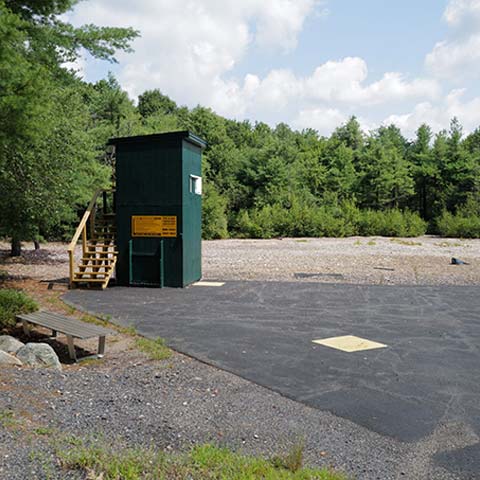The Skeet Field is open to members as well as non members who are actively working on joining. Skeet shooting is on Sundays 9 am-1 pm, and occasional Wednesday evening 6 pm – 9 pm, weather permitting.
This is a very informal group and there is always someone who can offer help and time with new shooters.
 Skeet is a recreational and competitive activity where participants attempt to break clay disks flung into the air at high speed from a variety of angles. For the American version of the game, the clay discs are 4 5/16 inches (109.54mm) in diameter, 1 1/8 inches (28.57mm) thick, and fly a distance of 60 yards (+/- 2 yards). The international version of skeet uses a target that is slightly larger in diameter (110mm vs 109.54mm), thinner in cross section (25mm vs. 28.57mm), and has a thicker dome center, making it harder to break. International targets are also thrown a longer distance from similar heights (over 70 yards), resulting in a faster target speed
Skeet is a recreational and competitive activity where participants attempt to break clay disks flung into the air at high speed from a variety of angles. For the American version of the game, the clay discs are 4 5/16 inches (109.54mm) in diameter, 1 1/8 inches (28.57mm) thick, and fly a distance of 60 yards (+/- 2 yards). The international version of skeet uses a target that is slightly larger in diameter (110mm vs 109.54mm), thinner in cross section (25mm vs. 28.57mm), and has a thicker dome center, making it harder to break. International targets are also thrown a longer distance from similar heights (over 70 yards), resulting in a faster target speed
The firearm of choice for this task is usually a high-quality, double-barreled over and under shotgun with 28- or 30-inch barrels and very open chokes.
Often, shooters will choose an improved cylinder choke (one with a wider pattern) or a skeet choke (one with a tighter pattern), but this is a matter of preference. Some gun shops refer to this type of shotgun as a skeet gun. Alternatively a sporting gun or a trap gun is sometimes used. These have longer barrels (up to 34 inches) and tighter choke. Many shooters of American skeet and other national versions still use inexpensive semi-automatic and pump-action shotguns with great success. The use of clay targets to simulate hunting scenarios is one reason the targets are called clay pigeons.
The event is in part meant to simulate the action of bird hunting. The shooter shoots from seven positions on a semicircle with a radius of 21 yards (19 m), and an eighth position halfway between stations 1 and 7. There are two houses that hold devices known as “traps” that launch the targets, one at each corner of the semicircle. The traps launch the targets to a point 15 feet above ground and 18 feet outside of station 8. One trap launches targets from 10 feet above the ground (“high” house) and the other launches it from 3 feet above ground (“low” house). At stations 1 and 2 the shooter shoots at single targets launched from the high house and then the low house, then shoots a double where the two targets are launched simultaneously but shooting the high house target first. At stations 3, 4, and 5 the shooter shoots at single targets launched from the high house and then the low house. At stations 6 and 7 the shooter shoots at single targets launched from the high house and then the low house, then shoots a double, shooting the low house target first then the high house target. At station 8 the shooter shoots one high target and one low target. The shooter must re-shoot his first miised target, or if no targets are missed, must shoot his 25th shell at the low house station 8. This 25th shot was once referred to as the shooter’s option, as he was able to take it where he preferred. Now, to speed up rounds in competition, the shooter must shoot the low 8 twice for a perfect score.
History
Skeet shooting was invented by Wlliam Harden Foster, an avid grouse hunter, in the 1920s as a sport called Clock Shooting. The original course was a circle with a radius of 25 yards with its circumference marked off like the face of a clock and a trap set at the 12 o’clock position. The practice of shooting from all directions had to cease, however, when a chicken farm started next door. The game evolved to its current setup by 1923 when one of the shooters, William Harnden Foster, solved the problem by placing a second trap at the 6 o’clock position and cutting the course in half. Foster quickly noticed the appeal of this kind of competition shooting, and set out to make it a national sport. The game was introduced in the February 1926 issue of National Sportsman and Hunting and Fishing magazines, and a prize of 100 dollars was offered to anyone who could come up with a name for the new sport. The winning entry was “skeet” chosen by Gertrude Hurlbutt.[citation needed] The word “skeet” was said to be derived from the Scandinavian word for “shoot” (skyte). During World War II, skeet was used in the American military to teach gunners the principle of leading and timing on a flying target. (sourced from Wikipedia)
